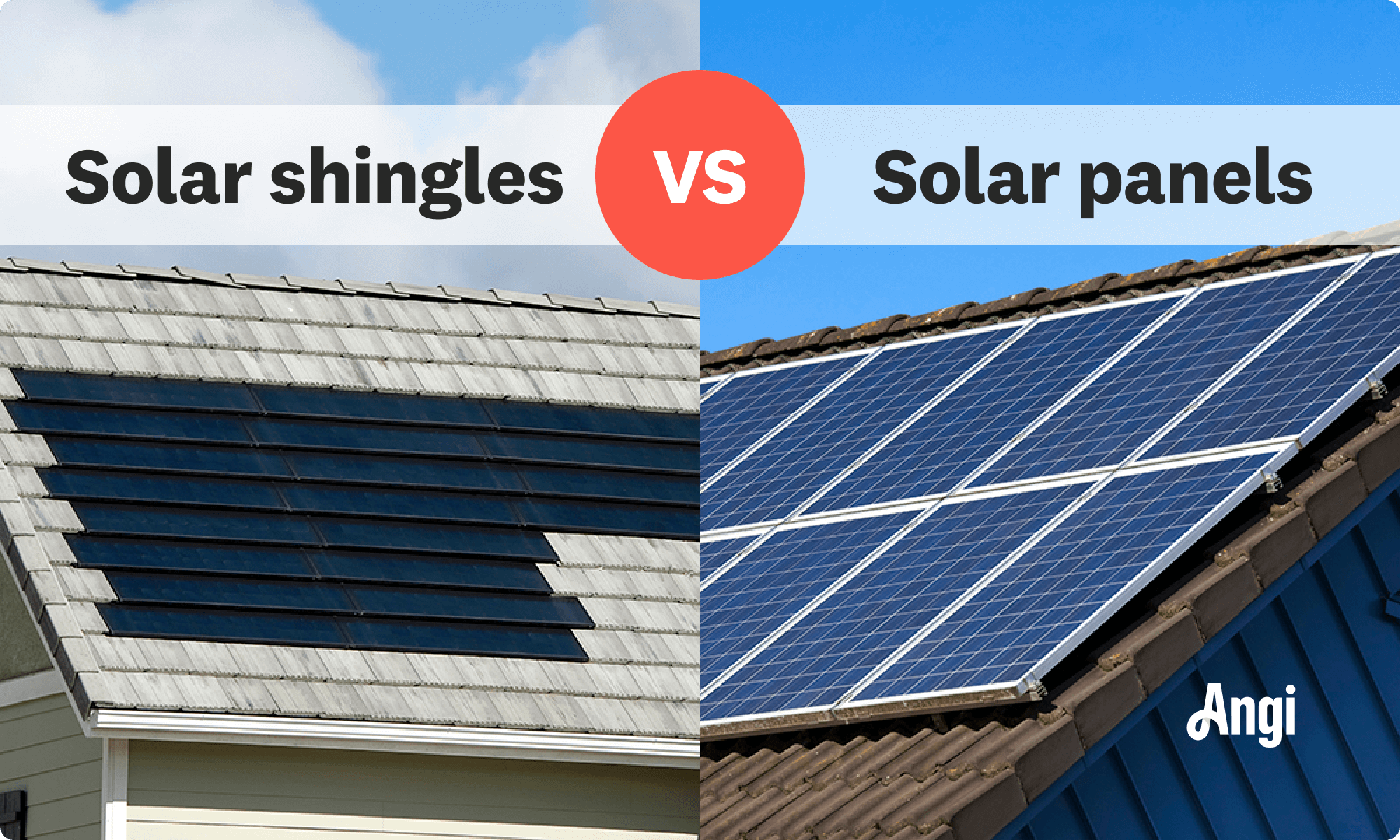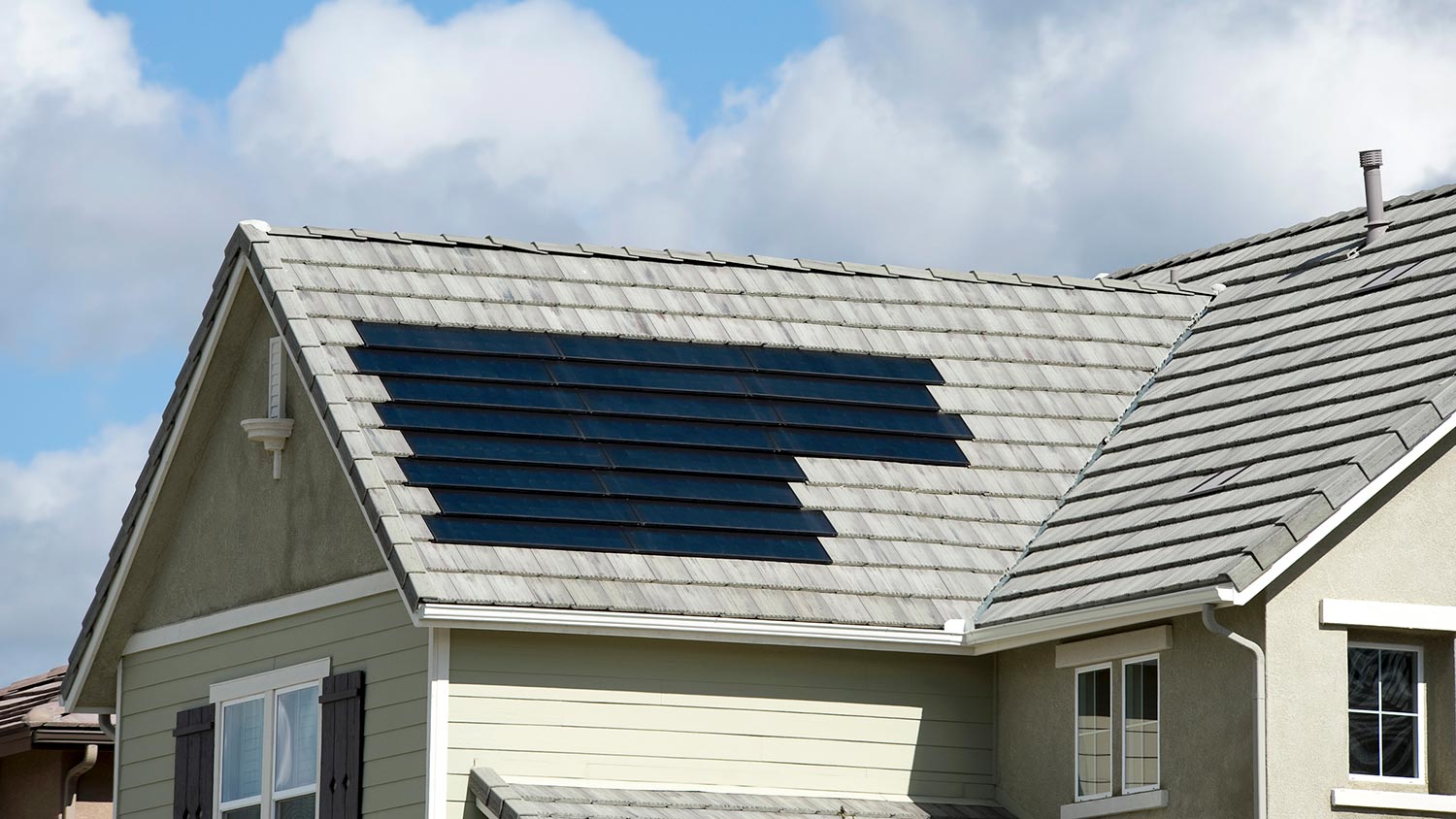
Discover the average solar panel installation cost, key price factors, and expert tips to help you budget for your solar project.
Weigh solar panels' portability and affordability against solar shingles' looks and lifespan


Solar panels cost between $18,400 and $36,400, while solar shingles cost between $21,000 and $50,000.
Solar shingles are easier to install than solar panels, but you might struggle to find a contractor who knows how to do it.
Although solar shingles last a little longer than solar panels, it’s not unusual for either product to last 30 years or more.
Solar panels can be installed on any elevated surface, making them more versatile than solar shingles, which can only be used on a roof.
Installing solar panels or solar shingles could increase the value of your home by as much as $15,000 when it is sold.
Many homeowners are looking for ways to go green and save on energy bills, but knowing exactly how to create a more sustainable home can be a daunting task. If you’re considering solar energy for your home, there’s one big choice you need to make: solar shingles or solar panels. Here are some factors to consider when deciding which is better for your home.

Solar panels and solar shingles harness the same technology but in different forms, affecting their efficiency and the situations in which they work best. Solar panels are traditional panel designs installed on a rooftop or on the ground near the building they’re meant to power. Solar shingles look similar to a standard roof shingle, except they’re made with solar technology. They’re small and blend well with other roof shingles, giving them a sleek, integrated look.
Solar panels are the most common solar energy option for homes. You’ve probably seen houses with large, blue or black panels shining in the sunlight as they absorb energy, inspiring you to look into getting panels of your own. As such, solar panels are typically installed on your roof, but they can also be installed on the ground, against a wall, or at a nearby site to absorb the most direct sunlight possible.
This form of renewable energy uses building-integrated photovoltaic systems, an inverter, a mount for supporting the panels, and silicon solar cells to capture the most energy. The state-of-the-art circuit inside the panels transmits energy captured by the silicon cells to your home’s electrical wires, providing you with electricity free of charge (once your unit’s been paid off, that is).
| Pros | Cons |
|---|---|
| Higher efficiency | Highly visible |
| More affordable than solar shingles | Longer installation time |
| Can be relocated |
Best for:
Those on a budget
Those in areas of low sunlight
Those who favor maximum energy efficiency over appearance
Solar panels are expensive, but they’re the most affordable solar power system option for residential users. A solar panel system typically qualifies for rebates and tax incentives that reduce installation costs, making it an even more affordable solar power source.
Solar panels can be installed to catch the sun’s rays at the best angles for optimum efficiency. Additionally, some systems can be programmed to rotate or tilt the panels to follow the sun for better solar absorption.
This type of system raises a home’s resale value. And if you move, you can uninstall the panels and reinstall them on a new property. While removing them might be labor-intensive and reinstalling them may be pricey, you don’t necessarily have to purchase new panels once you’ve invested in a solar panel system.
There’s no hiding solar panels, and some people find them unattractive. Monocrystalline models have a blackish color that blends with roof shingles better than bluish polycrystalline panels, but you’ll still have noticeable panels on the roof or ground.
Solar panel installation takes time, especially if you consider the time it takes to get the required permits and final inspection. The average installation time takes around three months but can vary by the installation company, local permitting and inspection requirements, system size, and the characteristics of your property and home.

Also known as solar roofs, solar tiles, or solar roof tiles, solar shingles are tile-shaped panels permanently installed on your home’s roof. The panels are much smaller than conventional solar panels, but they operate in a similar way, with building-integrated photovoltaic systems, an inverter, and a circuit that allows the solar energy to be absorbed and flow through the wires into your home.
| Pros | Cons |
|---|---|
| Sleek and stylish | Expensive |
| More durable than solar panels | Stay with the home |
| Easier to install | Less energy efficient |
Best for:
Those who want a seamless look
Those who prefer a permanent solar power solution
Those with a higher budget
Solar shingles function like mini solar panels that connect to a photovoltaic power system. Their size and shape allow them to seamlessly integrate with the other shingles on a roof. However, their color will be black or blue like other solar panels. Solar shingles can qualify for solar power incentives and rebates, though it depends on local regulations. They can also increase the value of your home.
These types of shingles are highly durable, withstanding inclement weather like standard shingles. That gives them an advantage over solar panels, which are more easily damaged by falling debris. Solar shingles are also easier to install because they can be done when repairing the roof, and you only need to do a section of the roof to start creating solar power.
While solar shingles are convenient and look good, they’re pricey. Very pricey. They might be eligible for tax credits, rebates, or other incentives, but the price will still be much higher than installing solar panels, which means you’ll need to weigh if solar shingles are worth it based on your plans for the home.
Solar shingles also aren’t as efficient as solar panels. Solar shingles are stationary and must be placed on the roof even if the roof’s position isn’t ideal for solar energy production.
If you ever sell, the solar shingles stay put as a permanent fixture of the home.
To help you get a better picture, here’s how solar panels and solar shingles measure up to each other. If you’re still not sure which is right for you, ask a solar company near you for advice.
Solar panel installation costs between $18,400 and $36,400, while solar shingles cost between $21,000 and $50,000. Prices vary by location, and the total cost of your project depends on how many panels or shingles you need to meet your home’s energy needs.
Though both solar shingles and solar panels have that infamous black or blue look, solar panels are bulkier and stand out more. Solar shingles, on the other hand, are sleek, modern, and less noticeable. They’re installed alongside standard shingles, creating a uniform finish (except for the color).
Solar panels can be installed on all types of surfaces and are not limited to roofs. Their functionality and adaptability go beyond the housing industry. In fact, solar panels have been used for traffic lights, on top of cars, and even in space. You can even uninstall them and take them with you if you move.
Installing solar panels takes longer and is a more technical process. An added layer of shingles must be installed beneath the panel first, and the roof may need reinforcing to account for the panels’ weight. Solar shingles might be easier to install, but they’re a newer technology, so finding a contractor might take longer.
Solar panels have a lifespan of around 25 years (though some can last much longer), while solar shingles have a 30-year lifespan. Note that there is no evidence of the actual lifespan of Tesla’s solar shingles, as they’re still relatively new.
Solar panels have been in use for much longer than solar shingles and are much more common. But, while solar panel technology is older, the efficiency rate is very high. In terms of solar cell conversion rate (efficiency), the Office of Energy Efficiency and Renewable Energy states that new solar panels are around 23% efficient, though some can reach up to 27%.
Solar shingles are less efficient in comparison simply because of their shape and size. They’re designed to blend with standard shingles, so they may have curves and grooves that further reduce efficiency. Additionally, they can only be placed on rooftops and may or may not face the sun at optimum times.
Both solar energy systems increase your home’s value by as much as $15,000.
From average costs to expert advice, get all the answers you need to get your job done.

Discover the average solar panel installation cost, key price factors, and expert tips to help you budget for your solar project.

Solar battery costs depend on the size of your system, labor, and capacity. Learn how much you could pay for batteries for home solar systems.

Discover the average solar panel inspection cost, what impacts pricing, and how to save. Get expert tips to keep your solar system efficient and safe.

Want to know how to clean snow off solar panels? Be safe and gentle, but don’t underestimate the sun’s ability to melt away your snowy problems.

Does homeowners insurance cover solar panels? Find out what’s covered, how to add extra protection, whether you need to insure leased panels, and more.

Many homeowners are looking to lower energy bills and also help the environment. Installing solar panels on a backyard shed can do both. Here's what to know.